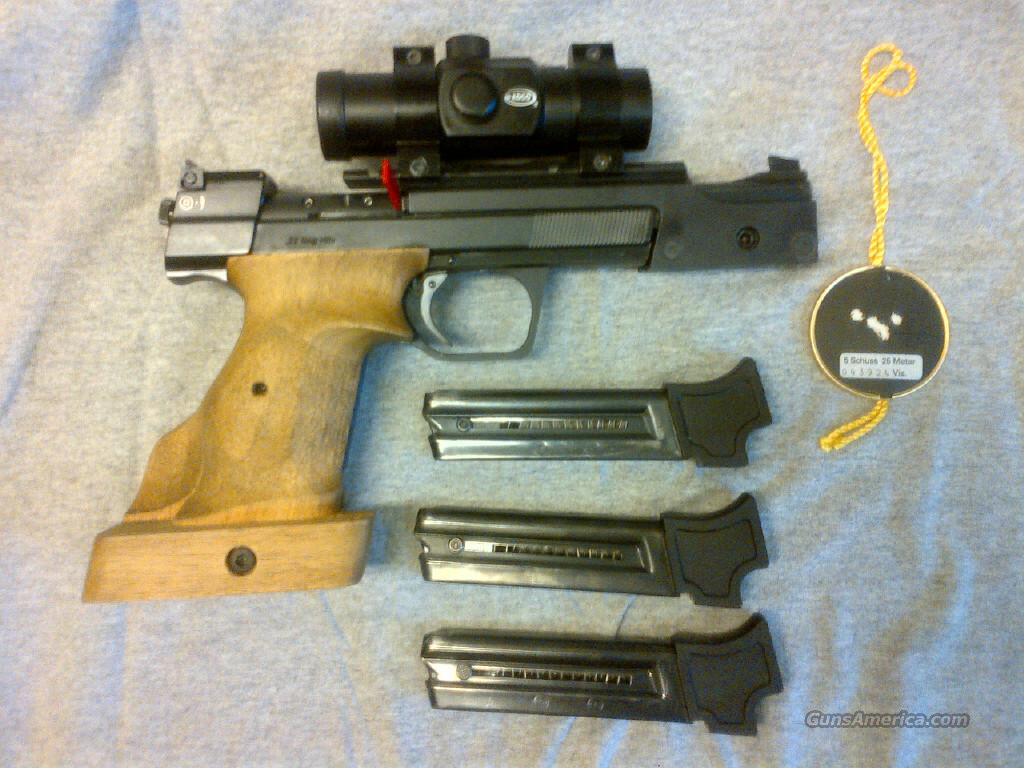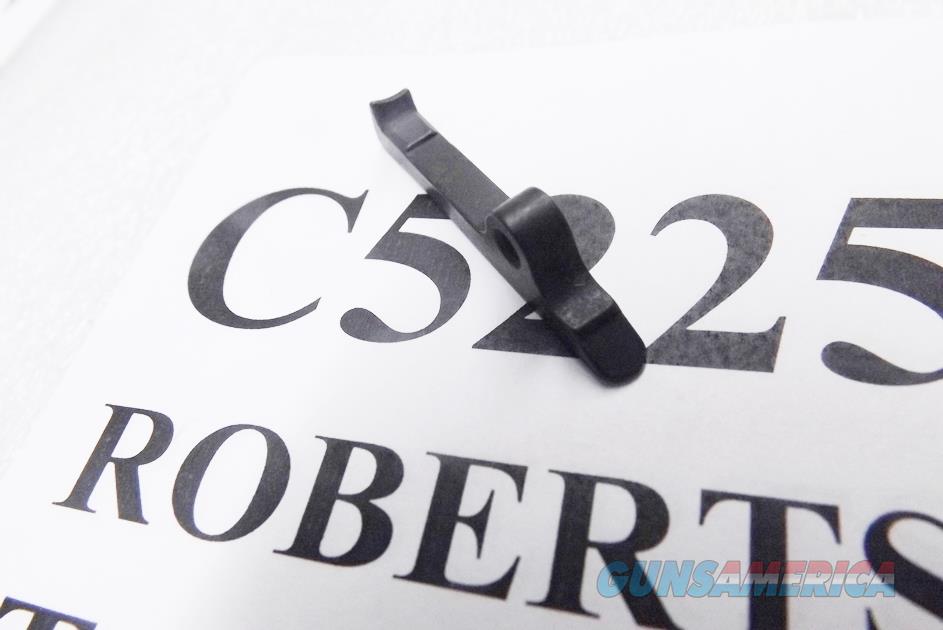Hammerli 208 International Manual Transmission
Hi, I have a Hammerli 208 International. It is one of the earlier models(serial number before 40335). The reason I mention the serial # is because that is where the differences exist. If I am not mistaken, the 208 International (serial #'s up to 40335) had triggers that are adjustable for trigger weight and backlash. The 208's produced from s/n#40335 have triggers that are adjustable for trigger weight, 1st stage weight, 1st stage travel, and 2nd stage travel.
I believe everything else is the same (interchangable front sights, rear sight assembly, internals, etc.). The 208s is the next model in the series.
According to Larry Carter (Larry's Guns of Maine - the Hammerli GURU!) the 208s is basically the same as the earlier 208's except for the addition of a sliding trigger shoe and squared trigger guard. Certain 208 International pistols can be converted to the 208s trigger by Larry but I am not sure which ones these would be. As for the box and accessories, I couldn't give you a specific response as the 208 I purchased had no box. Just the pistol and 2 magazines. I do have an early model Hammerli 280 and this has the original red cardboard box with the metal reinforcements on it corners. The pistol sits on grey soft foam with appropriate cutout for the pistol and an accessory case.
The Highest Standards: Hammerli 212. By James Clerk Maxwell. (Furter) refined a number of aspect of the guns, eventually producing the model 206, and 208. His tips for care of the Hammerli 208s are excellent and are recommended for any fine., proper cleaning and maintenance can give your 208 a long and trouble.
The tool kit is in a plastic (red with clear front) pouch. There is a manual, test target, and some Hammerli patches. I have seen some 208 Internationals for sale with all accessories and box and they were quite similar to my 280. What to look for on the pistol? The main thing is to take off the left side grip panel and the slide. Follow the recoil spring back to where it stops in the frame. About an 1/8 of an inch back, and directly under the front of the ejector, look for any cracks (hair-line, etc.).
This is the usual area where the frame could crack. I've never experienced this but I have seen photos on line. I can only speculate that it was due to high velocity ammo, weak spring, etc. Take your pick. Usually the 208 is the pistol which all others are judged. They are uncanily accurate, sit well in the hand, and, like all Hammerli's, have exceptional triggers. Mine was $1250 US and was just the pistol with two magazines.
Probably wasn't the best price but they are difficult to find and I was looking for quite some time. If you can, test fire the pistol with some good ammo, take it down and give it the once over. Parts are not a problem (call Larry!). If the gun is clean, go for it!
Hope this helped, RickP. I call upon the experts in this field for assistance. I am looking into a Hammerli 208. It comes in a cardboard box with tools. Is this the way it came from Hammerli? RR I have recently bought a new 208s (built in 1996, but fired only for the test target and at the Belgian Test Bench), from a legacy.
It came in a blue carboard box, with a red plastic tool 'wrapper', 2 mags, cleaning kit & the test target. I swapped the original grip for a smaller one (can't stand those big grips), and love it to pieces.
Cleaning and Adjustments for the Hammerli 208s Cleaning and Adjustments for the Hammerli 208s Back to This text originally appeared in the for the. During the Dixie Matches held in Florida in March 2000, Mr. Larry Carter of Larry’s Guns spent some time with the Air Force National Pistol Team members discussing the care and cleaning of the Hammerli 208s. He described both basic and detailed cleaning and maintenance as well as adjustments to the trigger. The detailed cleaning/care involves punching out pins and disassembling the internal parts.
This should not be done soley from notes, and is only necessary on a semi-annual or annual basis, depending on how much shooting is done. Therefore, detailed notes will not be covered in this document. Carter emphasized that NO chemicals or cleaners should be used for any portion of the cleaning of the 208s pistol. He further emphasized that oil must NOT be allowed into the hammer/sear region as this will wash away the special Moly lubrication, which will cause sear wear. The detailed care may be necessary if any contaminants enter the hammer/sear region or if the first stage of the trigger starts feeling as though it drags. Basic cleaning should be done after each match. For cleaning, the materials/lubricants used were: a.
One specially formed brass brush. This brush is used to clean the chamber.
It is made by bending a.25 caliber bore brush at a right angle so that the tip length matches the length of an empty.22 case. One M16 style cleaning brush (toothbrush style with smaller brush at end of handle). Cotton swabs to use for cleaning and for lubrication. D.22 caliber patches.
Cleaning cloth. A mechanic's cloth is recommended. Nylon cord such as weedeater line or similar. This will be used to PULL cleaning patches through the bore.
Prepare one end of the cord by melting it so that it clears the bore but will hold on to patches. Form the other end into a point that will easily pierce the.22 caliber patches. CLP type lubricant. Molybdenum (Moly) grease which does NOT contain graphite. Steps involved in cleaning the 208s: a.
Disassemble the pistol far enough to remove the slide. Remove the grips. Remove the trigger bar spring and the bar itself. Note that the spring is supposed to be bent to the side. Do NOT attempt to straighten it. Additionally, the curve should be circular.
If the spring is flat or the curved area has a flat section on top, replace the spring. If there is a buildup of debris under the ejector, carefully remove the recoil spring by pushing in on the end with a small flat blade screwdriver and turning so that the post clears the slot in the frame.
Do NOT point the spring toward your face as you remove it, as it is under pressure and could easily fly out of the frame. After the spring is removed, lift the ejector out of the frame. Clean the frame using the M16 style brush.
Be VERY careful not to dislodge or bend the slide stop spring. Use a cloth around the brush for the magazine well. LEAVE the hammer area alone. It should not need cleaning. Clean chamber using cotton swabs first. Next use the specially formed.25 caliber brass brush by inserting it into the chamber and twisting back and forth several times.
Place a patch on the nylon cord and pull it through the bore threading the cord from the chamber through to the muzzle. A patch should be sufficient, however if a brush must be used, do the following: Place the empty rod carefully through the bore from muzzle to chamber first. Next screw the brush onto the rod. Finally, PULL the brush through the bore from chamber to muzzle.

Repeat patch procedure. NEVER push a brush through the barrel in either direction. If the crown needs cleaning, use the cloth only. Note that if the dirt pattern is clearly visible, it should show close to perfect symmetry. Clean the ejector and recoil spring assembly. Place the ejector into the frame and the spring assembly into its slot. When setting the spring, start with the post pointing toward the barrel, push to just before the slot, turn the post to engage the slot and lock it into place.
Hammerli 208 International For Sale
Note: Wear marks will be visible on the spring. When the wear approaches one-quarter of the diameter of the wire, replace the spring. Dampen a cotton swab with CLP. Paint a light film of oil under the area where the trigger bar will rest.
Place a small amount of Moly lube on three places on the trigger bar: the hole which engages the trigger; the post which contacts the slide; and the hook which engages the sear. Place trigger bar in frame and then put spring in place with the ends pointing toward the muzzle. Ensure that the spring is in the slot on the trigger bar, not under the bar. Using an oil-dampened swab, lightly swipe sides of frame and center inside of slide where hammer rides. Place grips on frame.

Place slide on frame. Place rear sight on frame. Carter said that the rear sight should always be placed back on the pistol to prevent the slide from dragging across the hand while firing. Note that NO chemicals were used for any portion of the cleaning and that only a very light application of oil was used. Do NOT over-oil. Carter also discussed the following trigger adjustments: a.
Initial Slack - The pistol has to have a small amount of initial slack to ensure re-engagement of the disconnector with the sear. To check this slack, with the grips removed, observe the contact point between the disconnector and the sear. Using the screw on the front of the trigger assembly, adjust to obtain a slight movement between the disconnector and the sear when the trigger is moved.
Hammerli Pistols 208
Trigger Stop - The trigger must have a slight movement between sear hammer disengagement and the stop. This will prevent the sear from riding on the hammer surface while the hammer falls. If this adjustment is too close, the sear will wear and need to be replaced. To adjust this, turn the allen screw in the frame ahead of the trigger assembly to ensure that the sear does not drag on the hammer as the hammer is rotated through its arc. First Stage Weight - Use the screw behind the trigger to adjust the first stage weight. Trigger Length - The positioning of the trigger will affect the weight and the length of pull.
Therefore, adjust the placement before setting the trigger pull. Do NOT over-tighten the locking screw! Minimal force is needed. Second Stage Adjustment - There are two concentric screws to adjust the second stage. The outer screw will adjust roll; in will increase roll and out will decrease roll. Do NOT back completely out.
Hammerli 210
If backed out too far loss of second stage and damage to the sear will result. If the outer screw is to be adjusted, first turn the inner allen screw inward, out of the way. After the outer screw is adjusted, the inner one can be used to set the weight; normally at two pounds. end of text.